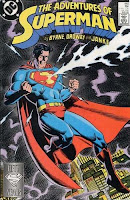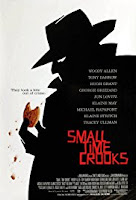 |
| Trinity |
Bringing together DC’s Big
Three for a world-saving spectacle is always an event and in 2003,
comicbook-superstar Matt Wagner presented an “untold tale”, a “what-if”, a
complete retcon actually, of the trio’s earliest adventures in
Trinity. The
story is big and bombastic as the heroes travel between the environs of
gleaming Metropolis, dirty Gotham, and lush Themyscira, while fighting the
combined villainy of the near-immortal Ra’s al Ghul, the Superman clone
Bizarro, and a fugitive Amazon going by the handle of Artemis. Wagner’s art,
always a pleasure to see, is fun as is reading early interactions between the
Big Three… if one ignores the plot’s faults.
Wagner produced this
three-chapter series at a time when his talents were focused more as a
writer; having his stylized art appear
in a prestige-format series was a treat for hardcore fans. Wagner’s Batman is a
menace of solid muscle and fluid shadows. Superman is portrayed an icon, a sun
god attempting to balance his humanity. His Wonder Woman is beauty personified
in her pose and grace, set apart from mankind, yet not above. Likewise, Ra’s is
dignified, taking pride in his arrogance and venom. Artemis is a punk, both
shallow and young. Yet, there is not a complete confluence between the sets of
three. Batman is angry for anger’s sake, yet somehow finds himself charmed by
the gorgeous Diana. Similarly, at no time does Wonder Woman get a full stake of
authority in the presence of her super boy friends. Artemis is never provided a
backstory and then never heard from again as clearly this is not the same
Artemis who eventually rises to the station of Wonder Woman herself. Even Ra’s
one-track plan of global conquest through global genocide is as ever-changing
as the sands of his birth; he never gets to one-up on the heroes, rather
constantly changes his attack for the convenience of the plot.
Ultimately,
Trinity is a
showcase for the Big Three to stand in the sun together and rejoice in their
triumph, and in their friendship. Wagner is successful at weaving in key
characterizations from each of the heroes, yet some of his decisions, again,
are merely opportunistic. The mindless Bizarro, used for brute strength alone,
does not live up to his potential as the human Batman takes-on the creature,
albeit in pre-
Dark Knight Returns-esque Bat-armor. The brutal slaughter of
Amazonian warriors by 21st Century war machines is both distressing and wholly
out-of-place thematically. Artemis’ strength, as well as her prowess, fluctuates inconsistently. Even Diana’s dip into a Lazarus Pit mostly goes ignored as,
thankfully, she is not resorted back as clay.
As a standalone, at face
value,
Trinity is a fun, action-packed tale of the world’s finest as they learn
to be comfortable around each other. Wagner’s cartoony-art style amps the
element of mirth; this is clearly a story to be enjoyed, not pondered upon.
However, one cannot help but wish the plot went deeper and that more risks were
taken, elevating what is a fun story to that of something spectacular.
Trinity has a lot to be
desired when trying to determine its place within the established continuity of
its three protagonists. If anything, Matt Wagner, when given the chance to
create a new and untold tale, blatantly ignores post-
Crisis, post-
Legends continuity
in order to fit the surroundings of his tale. Other than trying to answer,
where would this story fit, one should ask if it even should.
A warning to all you
readers, here below is where geeks reside.
Crisis on Infinite Earths
ended with the original Wonder Woman devolving back to clay as the multiverse
is reset. Heroes rise anew.
Superman is launched in a birthing matrix from a
sterile Krypton. A ten-year-old Bruce Wayne witnesses his
parents’ murder as a
string of broken pearls fall to the ground.
Flashes and
Hawkmen come and go.
And the DCU is set for its age of Legends.
Crisis was followed up
with the series
Legends that forged a path for the characters who had since
been rebooted to go forward anew and end with the reformation of the all-new,
all-different
Justice League.
Legends also reintroduced Wonder Woman to the
post-
Crisis DCU. Now how much time actually passes for the characters until the
events in
Legends occur is debatable, as are all comic book timelines, but the
Zero Hour timeline places a four year mark starting from the debut of
super-hero mainstays such as Superman, Batman, Black Canary (the Post-
Crisis
Wonder Woman surrogate), Green Arrow, and Aquaman (more on him later), as well
as second-tier characters such as the Elongated Man and Zatanna, up until
Legends, and the debut of Wonder Woman. Meaning, a lot of time has already
passed since the establishment of Superman and Batman and the so-called Heroic
Age until these heroes meet Diana of Themyscira.
 |
| Wonder Woman #1 (Feb '87) |
Wonder Woman Vol 2
launched in February 1987 and aside from
Legends, she remained mostly inclusive
to her own title. Even the next multi-title crossover,
Millennium, only sees
sparse action from Diana. Aside from lending an assist to the Green Lantern
Corps and a quick cameo from the League, her
Millennium crossover issues
primarily dealt with an established conflict internal to her own series.
Wonder Woman’s next
participation on the grand DCU stage is her big “date” with Superman. Superman,
at the time, had been dreaming of the Amazon princess since
Legends. Comic
creator John Byrne, who was the chief Superman architect since his
Man Of
Steel reboot, decided to tease the fans with a Superman/Wonder Woman romance.
Adventures of Superman #440 (May 1988)
 |
Adv. of Superman #440
(May '88) |
ends with the two meeting, and Superman
immediately engaging with a lip lock worthy of his kiss with Lois in
Superman II. That super-smooch directly leads into
Action Comics #600 (May 1988), where
fans realize that such a romance is not, nor will it ever, be. That issue also
marks the change in the title’s format and becomes a weekly book (for the next
42 issues); prior to #600,
Action was the designated Superman team-up book
since Byrne’s reboot of the character. However,
Adventures #440 also was
important for another reason.
 |
| Superman #1 (Jan '87) |
Starting in the rebooted
Superman #1, Superman discovers a scrapbook containing press clippings of his
earliest exploits; he then proceed to turn the book over to Batman to look into
this mystery. The scrapbook, it was discovered, belonged to the Kents, proud
parents of the soon-to-be Superman. And really, the scrapbook is irrelevant.
However, it is in this issue that Batman learns Superman’s identity. As a
result, Superman uses his x-ray vision and peeks behind Batman’s cowl,
discovering the vigilante is Bruce Wayne. Four years of activity and knowledge
of each other finally led up to this discovery – a first in the post-
Crisis
DCU. Superman files away and immediately lands in the arms of Diana.
Let’s now get back to
Trinity,
a story supposedly set during their early careers.
Throughout
Trinity, Batman
is shown in his gray outfit with the simple black bat insignia. This in itself
is not the most glaring of continuity errors. Even though this story should be
set in the time where Batman’s costume sported the yellow oval, there are
plenty of creators that ignored such detail for what could be looked at as
out-of-continuity stories, such as those presented within the
Legends of theDark Knight anthology series.
Why should Batman have the
yellow oval? Because as of
Adventures #440, that was his established costume
and that was when the heroes learned each others’ identities. Within
Trinity,
such secrets are already open as Clark Kent receives a ride from Bruce Wayne.
Another inconsistency is
the appearance of Wonder Woman’s invisible plane. When the Wonder Woman title
was rebooted, she was granted the ability of flight, so the need for such
transport was irrelevant. Wonder Woman’s invisible plane does not make its
official post-
Crisis appearance until much, much later in the continuity of her
title. Again, this can be possibly dismissed with a
No-Prize worthy thought
along the lines of… maybe the Amazons had it lying around the Diana wanted to
take it for a test drive. Right?
An argument could be made
that
Trinity happens following the team-up in
Action #600, after all, this
would still be an early adventure as far as Wonder Woman is concerned. The only
other allusion to how early an adventure this might be occurs during the
heroes’ visit to the Batcave, where a young, dark-haired lad is shown. The boy
is never mentioned by name but this could easily be
Jason Todd, who was the
active Robin at the time.
However, and in spite of
all that has been referenced, there is one underlying factor that destroys any
sense of continuity: Aquaman.
In issue 3, Batman is
racing underwater in a Bat-sub only to encounter –
for his first time –
Aquaman.
 |
Secret Origins #32
(Nov '88) |
Obviously, if Clark and
Bruce are already hip to each other’s aliases, Aquaman would have been well
established not to mention being a founding member of the
Justice League ofAmerica. Aquaman’s appearance eradicates any semblance of post-
Legends
continuity. Boom. Good-bye. Welcome to the end of the map.
Maybe not all is lost.
Let’s look back further then. Perhaps this could be a hidden story from a
pre-
Crisis Earth-1 detailing one of the first times Superman, Batman, Wonder
Woman, and Aquaman, all met. Unfortunately there are continuity errors with
that as well. Most noticeably, Bizarro, who is referred to as a clone multiple
times. The
Bizarro clone was introduced post-
Crisis as an attempt for Lex
Luthor to gain possession of a completely subservient Superman. In fact,
Luthor, who is a corrupt businessman in the post-
Crisis DCU, has his LexCorp Tower
shown in the pages of
Trinity. Yes, the pre-
Crisis Bizarro was a Superman
“duplicate”, also created by Luthor, but set more in vein as a Frankenstein’s
Monster, albeit one who worked everything in reverse.
End result?
Trinity is a
fun read that is completely ignorant of any sense of continuity and really
should have carried the Elseworlds banner, which was a DC imprint allowing
top-tier creators, such as Matt Wagner, the opportunity to play with known
characters in different, alternate settings.
Trinity would have been perfect
for this imprint and would have allowed Wagner the freedom push those
relational boundaries a lot more than he did.
Trinity is fun, but also
probably best forgotten.
As Always,
theJOE






























